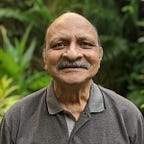Learning from Our Body
Gregory Bateson the anthropologist and social scientist stated that,
“Relationships are the essence of the living world. Biological form consists of relationships not parts.”
The various characteristics of our bodies reflect a deep interconnectedness and interdependence. Relationship is the key determinant of life.
Different yet not Separate
In our bodies, there are more than 35 trillion cells and these cells are not of the same type. There are at least 200 different types of cells like blood cells, immune cells, muscle cells, nerve cells and so on. Even though the cells are different they are not separate from one another. They are in continuous relationship with one another; collaborating in harmony to keep us alive.
The body is inclusive.
Interconnected and Interdependent
There are 11 different systems in our bodies like the circulatory system, respiratory system, digestive system and so on. Each of these systems consists of organs and tissues which are interrelated and interdependent and work towards fulfilling a particular purpose. However, even though a system may seem to be complete by itself, each of these systems within our bodies are interdependent and interconnected. The digestive system cannot claim to be independent of the circulatory system or the immune system cannot perceive itself to be independent of the nervous system and so on.
The body is not a machine that can be reduced to its parts but is an integrated whole.
Unbroken Wholeness
Whenever a part of the body is incapacitated as when one loses one’s right hand then the body compensates for this loss by making the left hand stronger. Or when one loses one’s sight then one gains an acute sense of hearing. The body seems to be consistently striving to attain an optimum balance. Similarly, when one experiences a cut or wound it is as if the whole body rushes in to orchestrate the healing of the wound.
There is an innate desire of the body to maintain its unbroken wholeness. No part is left alone in isolation to suffer. Unity and balance are continuously being sought.
Open System
Our bodies are open systems. The body inhales oxygen and exhales carbon dioxide. It ingests food and excretes waste. The body cannot isolate itself from the environment it lives in. It is in an ongoing relationship with this environment. It is ceaselessly adapting to its environs.
The body lives in the mainstream of life, exploring its possibilities and potential as it interacts with the environment.
Continuous Renewal
The body is regularly renewing itself. Most of the body is in a constant state of flux as new cells replace old ones. The stomach cells get renewed every 5 days. The red blood cells last only 120 days. The epidermis is recycled every 2 weeks. And the liver is turned over every 300 to 500 days. This is the body’s way of fighting entropy.
The body seeks, through renewal, to prevent itself from rapidly devolving into disorder.
What we experience with our bodies we need to consciously manifest in our individual, societal and organisational behaviours. Our mindsets need to shift from separateness to inclusiveness, from a mechanical perspective of reducing everything to its parts to a quantum perspective of seeing the wholeness of life, from self — centredness to other — centredness, from isolation to immersive involvement and from static stagnation to a dynamic life fulfilling renewal.
This is life.
As Teilhard de Chardin the palaeontologist stated,
“The egocentric ideal of a future reserved for those who have managed to attain egotistically the extremity of ‘everyone for himself’ is false and against nature. No element could move and grow except with and by all the others with itself… To reach the sun nothing less is required than the combined growth of the entire foliage.”
